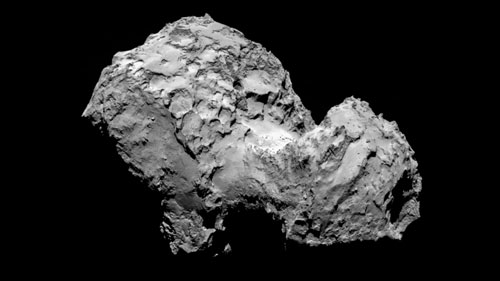| Aug 08, 2014 |
Successful rendezvous with Comet 67P/Churyumov-Gerasimenko
|
|
(Nanowerk News) The ESA Rosetta spacecraft has travelled over 6.4 billion kilometres, swung by planets, examined two asteroids during flybys, and spent more than two and a half years in hibernation during its 10-year journey. On 6 August 2014 at 11:30 CEST, with the Philae lander on board, it arrived at its target comet and entered into orbit.
|
|
Now, the mapping of the comet, which appears to consist of two interconnected parts, will begin. The first ever landing on a comet is expected to take place on 11 November 2014. The Philae lander is controlled and operated from the Lander Control Centre of the German Aerospace Center (Deutsches Zentrum für Luft- und Raumfahrt; DLR).
|
|
Witness from the past
|
|
Rosetta is now 404 million kilometres from Earth. During the approach, 67P/Churyumov-Gerasimenko has provided surprises; instead of a potato-shaped body, the comet researchers saw a nucleus that was shaped much like a duck, with a head and body. The first temperature measurement showed that the comet awaiting Philae did not have much ice, but rather a dusty and probably very rough surface. "Now that we have arrived at the comet, at 100 kilometres up, we know a great deal more about Churyumov-Gerasimenko," says comet researcher Ekkehard Kührt from the DLR Institute of Planetary Research. "The extensive investigations conducted close to the comet will be exciting and unique."
|
 |
| Comet 67P/Churyumov-Gerasimenko on August 3, 2014.
|
|
Eleven instruments are traveling aboard the Rosetta spacecraft and 10 on board the Philae lander, which will deliver the first data directly from the surface of a comet. Surface conditions, temperature, physical composition of the comet nucleus, organic molecules – everything is interesting for the comet researchers, because 67P/Churyumov-Gerasimenko was very likely formed from primordial material during its flight through the cold regions the Solar System and has changed less than other celestial bodies: "We are looking at an eyewitness to the origin of the Solar System, 4.5 billion years ago," says Ekkehard Kührt. "Comets have, in the past, been preserved in a frozen state as if in a refrigerator and thus exhibit many features from the early days of the Solar System. However, the first pictures show that the comet has not gone unscathed over time," says Kührt. "Many exotic structures on the surface suggest a certain evolution – and now is the time to understand it." In addition, comets and their impacts could have ensured the delivery of water and molecules necessary for the emergence of life to Earth.
|
|
The search for the perfect landing site
|
|
Now, the landing site selection, during which the best place on the duck-shaped body for Philae will be chosen using data from the cameras and other scientific instruments, starts. Numerous criteria must be considered and sometimes a compromise must be found. "We need, for example, on one hand sunlight, so that the batteries can be recharged using the solar arrays; on the other hand, the surface of the comet should not be too hot or outgas too strongly," explained DLR scientist Stephan Ulamec, Head of the Lander Team. However, the roughness of the surface and the nature of the ground are crucial for a safe landing. Last but not least, a good 'line of sight' to the Rosetta spacecraft is important to regularly transmit the data acquired by the 10 lander instruments via this connection back to Earth, and to receive commands sent from the Lander Control Centre at DLR Cologne via the main spacecraft.
|
|
At the end of August, an initial selection of up to five possible landing sites will be made by the scientists and engineers at DLR and the other partners in the lander consortium led by DLR. "Favourable landing areas are located on the 'head' and the larger part of the comet – the 'neck' region is not really suitable," says Stephan Ulamec. By mid-September the two best sites will have been filtered out of the 'top five'. In mid-October – one month before landing – the final decision will be made as to where the Philae lander will touch down.
|
|
Waiting for the first signal from the comet's surface
|
|
Since commands take 30 minutes to travel from Earth to the spacecraft and lander, the engineers will not be able to intervene during the landing process itself. Instead, a few hours before Philae separates from Rosetta just a few kilometres above the surface, the DLR engineers will send a computer sequence for the descent and landing of the spacecraft. At just over three kilometres per hour, Philae will then descend onto the comet. To prevent the lander from bouncing off of the nucleus in the low gravity of 67P/Churyumov-Gerasimenko, two harpoons will immediately be fired into the comet surface to anchor it on the small celestial body. In addition, ice screws in the feet of the lander will rotate into the ground, and a cold gas thruster at the top of the lander will push gently towards the comet. "We will know whether everything has gone well 30 minutes after landing, when we receive the data in the control centre," says Stephan Ulamec. The DLR ROLIS camera, which is mounted on the underside of the lander, will then send its first pictures of the descent.
|
|
Together, Rosetta and Philae will then accompany the comet on its way to the Sun – and observe how 67P/Churyumov-Gerasimenko becomes increasingly active, ejecting gas and dust particles into space. "The ongoing investigation from orbit and directly on the comet surface are both firsts that have not been met achieved by any other mission," says Ekkehard Kührt. "Our knowledge of this still mysterious celestial body will grow significantly with the Rosetta mission."
|

